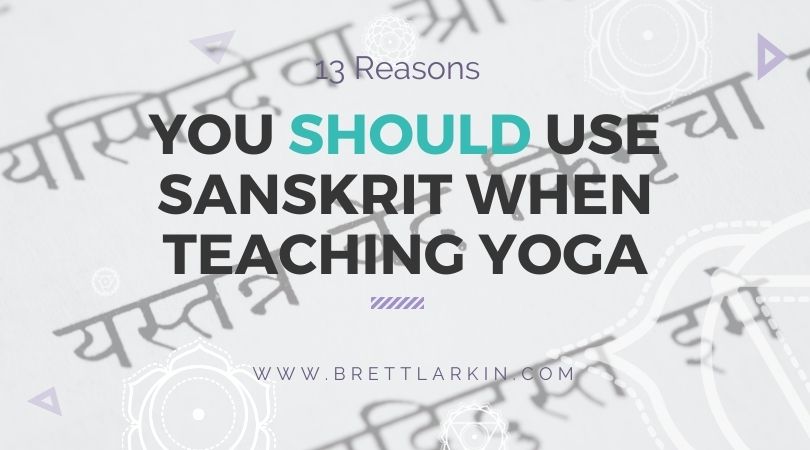
To use Sanskrit or not to use Sanskrit… that is the big question for many yoga teachers these days!
One of the most common questions we yoga teachers find ourselves asking is “do I need to use Sanskrit to teach yoga?” Does it really help students deepen their practice, or is does it confuse them? More difficult to grapple with is the question of yoga snobbery.
There’s nothing more annoying than a yoga teacher who uses Sanskrit to boost their own ego. Ugh!!
While there is definitely no set of definitive “yoga rules” that say you absolutely have to use Sanskrit while teaching yoga, there are some strong arguments for why you might want to. Learning a new language can be challenging, so be sure to bring your adhikara – or mindset of the student – to your approach. Def check out my Sanskrit glossary if you’re brand new to the language for words I use most commonly as a teacher, or my quick and dirty guide for the 10 essential yoga terms every yogi must know for starters.
Jump ahead:
- Sanskrit is a unifying language
- Many Sanskrit words for yoga postures tell stories
- …and others literally explain what the heck the pose is supposed to look like.
- You’ll get respect from other yoga teachers
- You can list it as a foreign language on job applications (kind of…well not really)
- Beginners will realize they have a lot to learn from you
- Learning a new language is sooo good for your brain
- It gives you a deeper understanding of yoga philosophy
- Sanskrit keeps us in touch with the heritage of our yoga practice
- It brings a sense of reverence and mysticism to the practice
- It’s a great way to open students up to a mantra practice
- It challenges you to step outside of your comfort zone as a teacher
- It makes you a more well-rounded instructor
When actually using Sanskrit in class, my top advice is to take it slow. Try incorporating just a few new words into your classes each week to keep it feeling natural and fluent rather than awkward and didactic.
There are some teaching situations when Sanskrit is definitely not appropriate. Read up below on when you should forget all of the good reasons to use Sanskrit to teach yoga and just use English (or your mother tongue) instead.
1. Sanskrit is a unifying language
Many yogis recognize and celebrate the language of Sanskrit. So when we utilize traditional Sanskrit terms in our teachings, we’re creating a connection of unity among our students. It becomes a universal experience that connects us beyond mere physical fitness.

2. Many Sanskrit words for yoga postures tell stories
Many Sanskrit pose names tell a story of spirit and myth. Not only do they teach valuable lessons, but they can give a sense of fun and whimsy to an asana class. One of my favorite examples of this is Hanumanasana – a yogic version of the front splits. The story says that Hanuman, the great monkey deity of service and spiritual devotion, needed to leap across a great canyon.
He was on a mission to rescue Sita, the captured love of his master Rama. To make the mighty leap, his back leg had to propel him forward with strength while his front leg reached forward with all his might. His hands clasped over his head in prayer, praying to his master with love. Hanuman was able to save the day, and now the iconic yoga posture is named in commemoration of his great leap.
3. …and others literally explain what the heck the pose is supposed to look like.
Bananasana – case in point. This is a restorative pose designed to target the side-body where you lie on your back and shape your body into, you guessed it, a banana. Sanskrit names are meant to give more context to the asana. If we’re not using Sanskrit names, we may be missing integral insights into many yoga poses.
4. You’ll get respect from other yoga teachers
If you learn how to pronounce Sanskrit words properly, you are showing your investment in the ancient practice of yoga. It’s no secret that there’s an influx of new yoga teachers in the health and wellness space. If you’re looking to stand out amongst the crowd, developing a deeper knowledge of Sanskrit and incorporating it into your classes can be a great way to do it. Including traditional Sanskrit names in your yoga classes will help you seem that much more knowledgeable as a yoga teacher.
5. You can list it as a foreign language on job applications (kind of…well not really)
Sanskrit is an ancient language that’s not really spoken outside of yogic and spiritual studies. So unless you intend to go on to become a Sanskrit scholar in the future, maybe leave it off the resume for now. It’s unlikely you’ll need to utilize the Sanskrit alphabet outside of yoga anyway.
6. Beginners will realize they have a lot to learn from you
Using the native language of yoga for your students may inspire them to take on a deeper study of the practice. New students coming to your class may be hearing Sanskrit for the first time. In this way, the use of Sanskrit can connect students and teachers to the tradition and heart of the yoga practice.
7. Learning a new language is sooo good for your brain
When you begin to use Sanskrit in yoga regularly, you’re gaining a deeper understanding of one of the oldest languages in the world. That not only benefits your students, it also benefits you as the teacher. Even learning the most common vocabulary from Sanskrit can develop new areas of your mind and strengthen your brain’s natural ability to focus. Feel free to turn this into a little brain game if you like! Learning new languages can also be super fun.
8. It gives you a deeper understanding of yoga philosophy
Aside from the traditional names of yoga poses, often Sanskrit names communicate meaning that is much deeper than a simple translation. Let’s look at the word “namaste” for example. If we tried to translate it to English, we couldn’t really do it with just one word. The word refers to something much deeper, and even the sound frequency of the word is taken into consideration. When you begin to study Sanskrit in-depth, you will acquire a basic understanding of the philosophy and the values that are so important to the practice roots.

9. Sanskrit keeps us in touch with the heritage of our yoga practice
The history of yoga is rich and expansive. While we couldn’t possibly cover it all here, you can read our brief history of yoga on the Uplifted blog. Yoga originated over 5,000 years ago in northern India. The word yoga was first mentioned in a set of four ancient sacred texts called the Rig Veda. The Vedas were written in – you guessed it – Sanskrit. Though it’s one of the oldest languages, connecting with Sanskrit is one amazing way to keep us in touch with the heart and history of yoga.
10. It brings a sense of reverence and mysticism to the practice
Most people haven’t heard Sanskrit before. So as a teacher, providing a Sanskrit name to a commonly practiced pose can nurture curiosity in your students. When something is different, our attention perks up. Our brain tells us to pay attention because something is new and different. and the more you can get your students to focus on their physical practice, the better!
11. It’s a great way to open students up to a mantra practice
As you start to sparingly insert Sanskrit into your classes, you may mention that Sanskrit words go beyond just yoga poses. It’s a personal choice you have as a yoga teacher, but incorporating mantras while teaching yoga could be a great way to highlight another specific, therapeutic benefit from the yoga tradition.
12. It challenges you to step outside of your comfort zone as a teacher
Sometimes we can fall into a rut or a “safe-space” as yoga teachers. If you’d like to challenge yourself, see if you can cross reference the common names you know for yoga poses and their traditional names. Once you learn that “Downward Facing Dog” is also “Adho Mukha Svanasana,” it’s fairly easy to start using the traditional pose names in your classes.
Save Hours with my Proven Formula. FREE Yoga Business Plan Download

13. It makes you a more well-rounded instructor
Teaching yoga – and practicing for that matter – is a life-long study. Jnana yoga is the pursuit of knowledge and is one of the revered paths a yogi can take. If you’re inspired to become a more knowledgeable teacher for your students, then putting in the extra effort to learn a bit of Sanskrit will make you a more well-rounded teacher.
Do I Need to Use Sanskrit to Teach Yoga? When You Should Just Drop It
Real talk time: even with all of these good reasons to use Sanskrit in your teaching, I will say there are some exceptions.
Even if you have a solid mastery of Sanskrit today, can you remember a time early on in your experience with yoga when you were just totally LOST in class, and your teacher’s use of a foreign language was NOT HELPING.
Teacher: OK, now transition from virabhadrasana II to forward fold, and then take a vinyasa. We’ll meet in uttana shishosana, engaging uddiyana bandha with a strong ujjayi to support your shape.
You: (Ummm what?) You pretend like you know what you’re doing and wave your arms around with a serene look on your face, feeling totally ridiculous.
Teacher: Uttana shishosana yogis! Not child’s pose! Butts up and breathe!
You: You fold yourself into a pretzel-y shape with your butt up in the air and giggle/cry to the mat. At least no one can see your face.
🙏
Yogis, this is just one of several examples I can think of when using Sanskrit as a teacher is not going to do you or your students any good. While it may seem obvious to some that you shouldn’t use Sanskrit without pausing to explain the translation when you have new students in the room, it’s easy to breeze through some basic terms that you actually forget are Sanskrit to begin with! Yoga, prana, and even om are a few of the most common Sanskrit words that go un-translated in many beginner yoga classes. Here are some other situations when you should consider letting go of Sanskrit and offer instructions in your native language:
- When offering pre-natal adjustments (to both new and experienced yogis, it’s important that these cues are clear and understandable)
- When teaching fast-flowing sequences
- If you’re not 100% sure that the Sanskrit term you’re using means what you think it means
- Whenever you feel out of your teaching depth (you might not have prepared properly for class, be covering new topics, or have a large number of students in your room)
- If the purpose of using the Sanskrit term is to boost your ego
Next Steps:
- Explore my Yoga Teacher Resource knowledge hub for more tips about how to grow your yoga business.
- Download my sequences for a jumpstart on your upcoming yoga classes!
- For more detailed tips, processes, and worksheets to supercharge your yoga business, download my yoga business launchpad course!

Sneak Peak into My 300-Hour YTT - FREE Videos, Info Session, Bonuses!

YOU MIGHT ALSO LIKE
- Somatic Yoga Workshop Ideas for Teachers
- Somatic Yoga For Yoga Teachers: Everything You Need to Know in 10 Steps
- How to Teach Somatic Yoga: A Practical Guide for Instructors
- How Much to Charge for Zoom Yoga Class: A Practical Pricing Guide
- Comprehensive Guide to Your Yoga Service Agreement
- How To Create Mindful Somatic Yoga Sequences Your Students Will Love
- What Is Mindset Coaching? A Complete Breakdown
- 5 Affordable Yoga Teacher Insurance Plans (Updated 2024)
- How To Make A Life Coaching Intake Form
- 7 Steps To Start A Life Coaching Business
- What Is A Self Love Coach? And How To Become One
- Self-Coaching: How To Become Your Own Life Coach
- Types Of Life Coaches: How To Choose Your Life Coaching Niche
- 20 Awesome Ways To Make Money As A Yoga Instructor
- Life Coach Marketing: A Comprehensive Guide For Long-Term Growth











